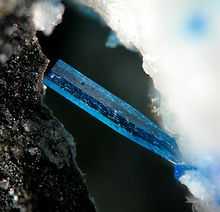Diaboleite
| Diaboleite | |
|---|---|
 Diaboleite at the American Museum of Natural History, in New York City | |
| General | |
| Category | Halide mineral |
| Formula (repeating unit) | Pb2CuCl2(OH)4 |
| Strunz classification | 3.DB.05 |
| Dana classification | 10.6.1.1 |
| Crystal symmetry |
Ditetragonal pyramidal H-M symbol: (4mm) Space group: P4mm |
| Unit cell | a = 5.880 Å, c = 5.500 Å, Z=1[1] |
| Identification | |
| Color | Blue |
| Crystal habit | As square tabular crystals, thin plates, massive |
| Crystal system | Tetragonal |
| Cleavage | Perfect on {001} |
| Fracture | Conchoidal |
| Tenacity | Brittle |
| Mohs scale hardness | 2.5 |
| Luster | Adamantine, pearly on cleavages[1] |
| Streak | Pale blue[1] |
| Diaphaneity | Transparent to translucent[1] |
| Density | 5.41 to 5.43 g/cm3 |
| Optical properties | Uniaxial (-) |
| Refractive index | nω = 1.980, nε = 1.850 |
| Birefringence | δ = 0.130 |
| Absorption spectra | O > E, in thick fragments[1] |
| Solubility | Completely soluble in nitric acid |
| References | [2] |
Diaboleite is a blue-colored mineral with formula Pb2CuCl2(OH)4. It was discovered in England in 1923 and named diaboleite, from the Greek word διά and boleite, meaning "distinct from boleite".[2] The mineral has since been found in a number of countries.
Description
Diaboleite is deep blue in color and pale blue in transmitted light. The mineral occurs as tabular crystals up to 2 cm (0.8 in) in size, as subparallel aggregates, or it has massive habit. Vicinal forms of the tabular crystals have a square or octagonal outline and rarely exhibit pyramidal hemihedralism.[1]
Formation
Diaboleite occurs in manganese oxide ores, as a secondary mineral in lead and copper oxide ores, and in seawater-exposed slag. Diaboleite has been found in association with atacamite, boleite, caledonite, cerussite, chloroxiphite, hydrocerussite, leadhillite, mendipite, paratacamite, phosgenite, and wherryite.[1]
A study in 1986 synthesized diaboleite crystals up to 0.18 mm (0.0071 in) in size using two different methods. The study demonstrated that diaboleite is a low-temperature phase, that is stable under hydrothermal conditions at temperatures less than 100 to 170 °C (212 to 338 °F). At higher temperatures, the first stable mineral to form is cumengeite.[3]
History
In 1923, diaboleite was discovered at Higher Pitts Mine in the Mendip Hills of Somerset, England,[2] and described by L. J. Spencer and E.D. Mountain.[4] The study of the similar mineral boleite was perplexing at the time and this new mineral only compounded the difficulty. As insufficient material was available for a full investigation, Spencer and Mountain named it diaboleite, meaning "distinct from boleite", out of "desperation".[5]
The mineral was grandfathered as a valid mineral by the International Mineralogical Association as it was described prior to 1959.[2]
Distribution
As of 2012, diaboleite has been found in Australia, Austria, Chile, France, Germany, Greece, Iran, Italy, Russia, South Africa, the UK and the US.[1][2] The type material is held at the Natural History Museum in London and the National Museum of Natural History in Washington, D.C.[1]
References
- Citations
- Bibliography
- Spencer, L. J.; Mountain, E. D. (September 1923). "Diaboleite" (PDF). Mineralogical Magazine (Mineralogical Society) 20 (102): 78–80.
- Winchell, R. E.; Wenden, H. E. (November 1968). "Synthesis and Study of Diaboleïte" (PDF). Mineralogical Magazine (Mineralogical Society) 36 (283): 933–939.
Further reading
- Cooper, Mark A.; Hawthorne, Frank C. (October 1995). "Diaboleite, Pb2Cu(OH)4Cl2, a defect perovskite structure with stereoactive long-pair behavior of Pb (super 2+)". Canadian Mineralogist 33 (5): 1125–1129. (subscription required)
- Palache, Charles (October 1941). "Diabloeite from Mammoth Mine, Tiger, Arizona" (PDF). American Mineralogist (Mineralogical Society of America) 26 (10): 605–612.
External links
 Media related to Diaboleite at Wikimedia Commons
Media related to Diaboleite at Wikimedia Commons
